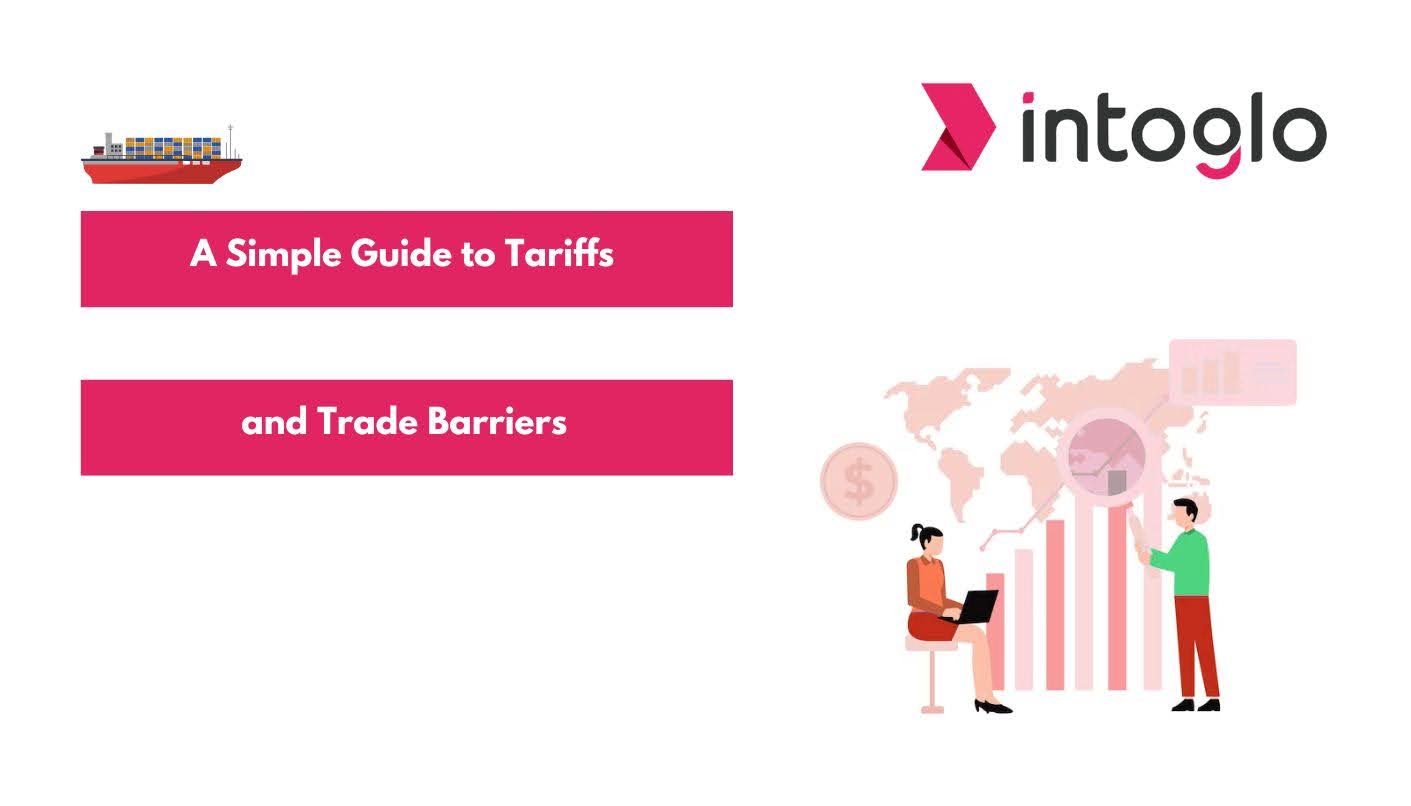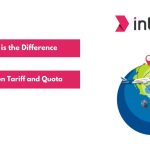If you’re involved in international business, understanding the obstacles that affect global trade is essential. Tariffs and other trade barriers often increase costs and complicate the movement of goods across borders, impacting profitability and operations. According to the World Trade Organization (WTO), trade policy barriers, including tariffs and non-tariff measures make up about 14% of total trade costs across industries worldwide.
In this blog, we’ll break down the different types of trade barriers. You’ll learn how these barriers affect pricing, market access, and supply chains, along with practical tips to help your business adapt and thrive in a complex global trade environment.
What is a Tariff?
A tariff is a tax that a government adds to goods coming from other countries. This makes imported products more expensive than local ones. The main reason for tariffs is to help protect local businesses from foreign competition by making imported goods cost more.
Common Types of Tariffs
- Ad Valorem Tariffs: A percentage of the value of the imported product. For example, a 10% tariff on imported cars means a $20,000 car would incur a $2,000 tax.
- Specific Tariffs: A fixed fee based on quantity or weight, such as $5 per kilogram of imported coffee.
- Compound Tariffs: A combination of ad valorem and specific tariffs.
To help businesses manage the impact of tariffs efficiently, tools like Intoglo’s FCL ocean shipping services offer transparent pricing and help reduce delays in moving goods internationally.
Tariffs can also be applied to exports, although this happens less often. While tariffs are one type of trade barrier, there are many other measures countries use to control trade. Let’s take a closer look at what trade barriers are and how they affect global commerce.
What are Trade Barriers?
While tariffs are taxes on imports or exports, trade barriers include a broader set of government policies that restrict or regulate international trade. These barriers can be monetary, like tariffs, or non-monetary, including rules and regulations that limit trade without directly taxing goods.
Types of Trade Barriers
Tariff Barriers: Taxes or duties imposed by a government on goods when they cross borders, either imported into or exported out of a country. These taxes increase the cost of foreign products to protect domestic industries, generate revenue, or influence trade policies. Tariffs can be calculated as a percentage of the product’s value or as a fixed fee per unit.
Non-Tariff Barriers: Rules and procedures that restrict trade without using taxes, including:
- Quotas: Limits on the amount of certain goods that can be imported.
- Import Licensing: Requirements to obtain official permits before trading specific products.
- Standards and Regulations: Health, safety, and environmental rules that products must comply with before entering a market.
- Subsidies: Financial support given to local producers to make their goods more competitive against imports.
- Embargoes: Complete bans on trade with specific countries or products.
Compliance with complex regulations can be challenging, but AI-powered tools such as Intoglo’s HS Code Lookup can simplify classification and ensure shipments meet required standards, minimizing costly delays.
Suggested Read: Avoid shipment delays with practical tips from our guide on navigating customs clearance smoothly.
These non-tariff barriers may be less obvious than tariffs but can greatly limit a country’s market access and trade opportunities. Understanding their role helps explain why countries rely on various tariffs and trade barriers as tools to protect their economic and political interests. Let’s explore the main reasons behind their use.
Why Do Countries Use Tariffs and Trade Barriers?
Governments use tariffs and trade barriers to protect local industries, support jobs, and maintain economic stability. These tools also help manage trade balances and can be used for political or security reasons. Governments use tariffs and trade barriers for several reasons:
- Protect Domestic Jobs and Industries: By making imported goods more expensive or harder to bring in, governments help local businesses compete better. This protects jobs and gives local industries a chance to grow.
- National Security: Some products are vital for a country’s safety. Restricting imports of these sensitive goods helps ensure they are produced and controlled domestically.
- Political Reasons: Trade barriers can be used as tools in diplomacy, such as applying pressure during negotiations or responding to unfair trade practices by other countries.
- Generate Government Revenue: Tariffs are a source of income, especially for countries that rely heavily on taxes from imports to fund government programs.
- Balance Trade Deficits: When a country imports more than it exports, tariffs and barriers can help reduce imports, aiming to improve the balance of trade.
- Encourage Domestic Innovation: By limiting foreign competition temporarily, governments give local industries time to develop new products and improve technologies.
Together, these reasons show why tariffs and trade barriers are important tools for governments to protect and promote their economic and political interests. Understanding their purposes also helps us see how these measures impact economies, businesses, and consumers worldwide.
Economic Effects of Tariffs and Trade Barriers
Tariffs and trade barriers don’t just impact governments and businesses; they also affect everyday consumers and the overall economy. While these measures can protect local industries, they often come with side effects like higher prices and fewer choices. Let’s take a closer look at how tariffs and trade barriers influence different parts of the economy.
1. On Consumers
Tariffs and trade barriers often mean higher costs and fewer options for shoppers. Here’s how consumers feel the impact:
- Higher Prices: Tariffs raise the cost of imported goods, which often leads to higher prices at the store. For example, tariffs on imported electronics or clothing can make everyday items more expensive for consumers.
- Less Variety: Non-tariff barriers like strict regulations or import quotas can limit the availability of certain products. For instance, stringent safety standards might reduce the range of imported toys or food products on the market.
2. On Producers
While protection can help local businesses grow, it can also affect how efficiently they operate. Let’s see what this means for producers.
- Protection: Domestic producers face less competition and can strengthen their market position. For example, local steel manufacturers may benefit from tariffs that make imported steel more expensive, allowing them to increase production.
- Reduced Efficiency: Without competition, some local industries might lack the motivation to innovate or improve quality. For instance, protected industries may delay adopting new technologies or cost-saving measures, leading to higher prices or lower-quality products over time.
3. On Global Trade and Economy
Trade restrictions don’t just affect one country, they can ripple through global markets and economic growth. Here’s a closer look.
- Trade Wars: Tariffs often trigger retaliatory actions. For example, the U.S.-China trade war saw both countries imposing tariffs on billions of dollars’ worth of goods, disrupting supply chains worldwide.
- Distorted Markets: Trade barriers can prevent resources from flowing efficiently. For instance, subsidies to local farmers may lead to overproduction domestically while limiting imports from more efficient producers abroad.
- Economic Growth: Excessive use of trade barriers can slow economic growth by restricting access to goods and services. Countries relying heavily on imports for manufacturing may face shortages or higher costs, hampering development.
Understanding these economic effects highlights the delicate balance policymakers must strike between protecting local interests and fostering healthy, open trade that benefits consumers and economies worldwide. Recent years have seen this balance tested through various trade disputes and shifting policies, making it important to examine current examples and trends in tariffs and trade barriers.
Recent Examples and Trends in Tariffs and Trade Barriers
Trade tensions have increasingly shaped the global economic landscape, underscoring how tariffs and trade barriers influence international relations and business operations. To better understand this dynamic, let’s look at some recent key examples and trends.
- U.S. Tariffs on Steel and Aluminum: In 2018, the U.S. imposed tariffs of 25% on steel and 10% on aluminum imports for national security reasons, targeting major exporters such as Canada, Mexico, and the EU. These tariffs significantly raised costs for American manufacturers. At the time, the tariffs were projected to add up to $22.4 billion in expenses on imported steel and aluminum products, impacting U.S. industries and supply chains.
- Retaliatory Measures: In response, affected countries implemented retaliatory tariffs on U.S. goods such as agricultural products and machinery, escalating trade tensions. For example, the EU imposed tariffs on $3.2 billion worth of U.S. imports.
- Trade Agreements Promoting Free Trade: While tariffs are increasing in some regions, agreements like USMCA and the EU Single Market reduce barriers among member countries, allowing free trade for more than 450 million consumers as of 2025, according to data from Statista.
- Global Impact: The WTO now projects global merchandise trade to decline by 0.2% in 2025, down from an earlier forecast of 3% growth. The slowdown is mainly due to rising trade restrictions, tariffs, and ongoing tensions between the U.S. and China.
These examples show the complex and shifting landscape of tariffs and trade barriers, underscoring the importance of staying informed for businesses and policymakers alike. Understanding these changes is especially crucial for businesses, as tariffs and trade barriers directly influence their operations and strategies.
How Tariffs and Trade Barriers Affect Businesses
Tariffs and trade barriers create a challenging environment for businesses engaged in international trade. The impacts are far-reaching, influencing everything from supply chains to pricing decisions. Here are some key ways tariffs and trade barriers affect businesses:
- Higher Costs: Increased tariffs raise the price of raw materials or finished goods, squeezing profit margins.
- Complex Compliance: Meeting different countries’ regulatory standards requires time, expertise, and resources, adding operational complexity.
- Supply Chain Adjustments: Businesses may seek alternative suppliers or locations with fewer trade restrictions. Partnering with providers like Intoglo, offering real-time tracking and smooth customs clearance, helps maintain efficient operations despite trade barriers.
- Pricing Strategies: Companies face the tough choice of either absorbing higher costs or passing them on to customers, striving to maintain both competitiveness and profitability. As tariffs increase the price of raw materials and finished goods, many businesses find their profit margins under pressure.
Suggested Read: Learn how to manage tariff costs effectively with our guide on calculating export duty from India to the USA.
- Delayed Deliveries: Non-tariff barriers like customs inspections and licensing can cause shipment delays, disrupting inventory and customer fulfillment.
- Market Access Challenges: Trade barriers may limit entry into certain markets, forcing businesses to rethink expansion plans or target alternative regions.
Navigating tariffs and trade barriers demands flexibility and foresight. Businesses that proactively manage these challenges can mitigate risks and capitalize on global opportunities.
Conclusion
Tariffs and trade barriers have a powerful impact on global trade, balancing protection for local industries with challenges like higher prices and limited market access. Understanding how these tools work helps businesses and consumers make smarter choices in today’s interconnected world.
Shipping internationally and expanding your market can be complex. Intoglo‘s expert freight solutions, real-time tracking, and AI-powered compliance tools simplify navigating tariffs and trade barriers.
Take the next step toward smoother global shipping with Intoglo. Get a quote and see how we can simplify your trade journey.
FAQs
1. What is the difference between tariffs and trade barriers?
Tariffs are taxes on imported or exported goods, while trade barriers include tariffs plus non-monetary restrictions like quotas, licensing, and regulations.
2. Why do countries impose tariffs?
To protect local industries, generate revenue, ensure national security, or influence trade balances.
3. How do tariffs affect consumers?
They typically lead to higher prices and less variety of imported goods.
4. What are some examples of non-tariff barriers?
Import quotas, product safety standards, licensing requirements, and subsidies to domestic industries.
5. Can trade barriers lead to trade wars?
Yes, imposing tariffs or barriers can provoke retaliatory actions, escalating into trade conflicts that disrupt global markets.





Leave a comment